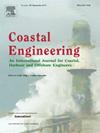波浪俯冲时能量耗散的力学
IF 4.5
2区 工程技术
Q1 ENGINEERING, CIVIL
引用次数: 0
摘要
恶劣条件下的海上作业往往涉及极端环境。尽管数值方案取得了进步,但在模拟这些波场方面仍然存在挑战。势流法的应用就是一个例子,它是有效的,但由于它在考虑波浪破碎引起的能量耗散方面的不足而受到限制。目前,经常使用根据实验观测校准系数的经验耗散模型。然而,这些系数如何在广泛的破浪情景中变化,从早期破浪到极端的波浪跳水,还没有得到很好的理解。本文的目的是通过更好地理解耗散力学来解释这些系数的变化。使用一个经过验证的两相reynolds - average Navier-Stokes (RANS)模型,该模型再现了暴跌波的基本物理特性,我们不仅加强了对波浪破碎造成的总能量损失的现有观察,而且还表明,对于暴跌波,77%的能量损失与波峰附近的流分岔密切相关,这导致了波浪的破裂。此外,约19%的能量损失可能归因于波浪压缩被困空气所做的功。与俯冲的射流和空气夹持相关的能量加起来可能占总能量损失的96%。本文章由计算机程序翻译,如有差异,请以英文原文为准。
Mechanics of energy dissipation due to wave plunging
Marine operations in harsh conditions often involve extreme environments. Despite advancements in numerical schemes, challenges persist in modelling these wave fields. An example is the application of potential flow methodology, which is efficient but limited by its inadequacy in accounting for energy dissipation due to wave breaking. Currently, empirical dissipation models with coefficients calibrated against experimental observations are often used. However, how these coefficients vary across the broad range of wave breaking scenarios, ranging from incipient breaking to extreme wave plunging is not well understood. The purpose of this paper is to account for the variability of these coefficients through a better understanding of the dissipation mechanics. Using a validated two-phase Reynolds-Averaged Navier-Stokes (RANS) model, which reproduces the essential physics of a plunging wave, we not only reinforce existing observations on the total energy lost due to wave breaking but also show that, for a plunging wave, 77% of that energy loss is closely linked to the bifurcation of flow near the wave crest that contributed to wave breaking. Additionally, ∼19% of the energy loss may be attributed to the work done by the wave compressing the entrapped air. Together, the energy associated with both the plunging jet and the air entrapment could account for up to 96% of the total energy loss.
求助全文
通过发布文献求助,成功后即可免费获取论文全文。
去求助
来源期刊

Coastal Engineering
工程技术-工程:大洋
CiteScore
9.20
自引率
13.60%
发文量
0
审稿时长
3.5 months
期刊介绍:
Coastal Engineering is an international medium for coastal engineers and scientists. Combining practical applications with modern technological and scientific approaches, such as mathematical and numerical modelling, laboratory and field observations and experiments, it publishes fundamental studies as well as case studies on the following aspects of coastal, harbour and offshore engineering: waves, currents and sediment transport; coastal, estuarine and offshore morphology; technical and functional design of coastal and harbour structures; morphological and environmental impact of coastal, harbour and offshore structures.
 求助内容:
求助内容: 应助结果提醒方式:
应助结果提醒方式:


